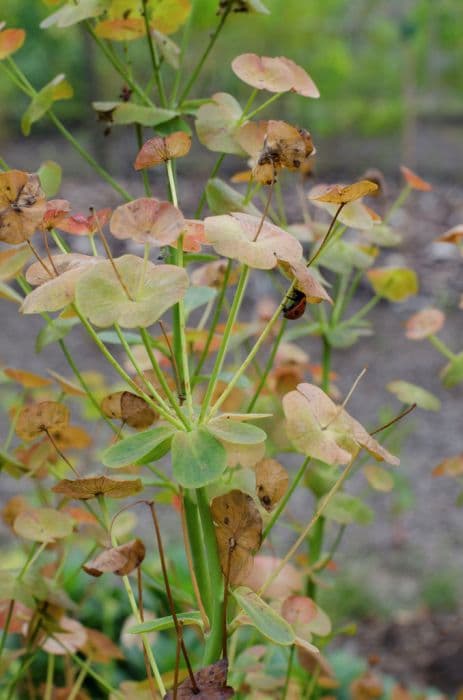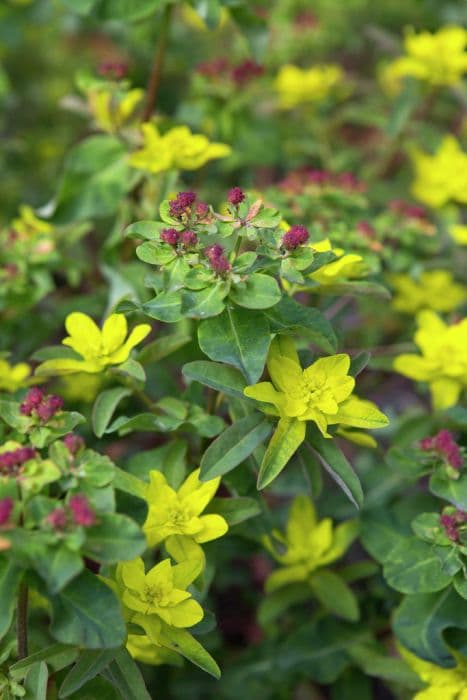Japanese Tallow Tree Neoshirakia japonica

ABOUT
The plant commonly known as Japanese wax tree has a distinct appearance characterized by its foliage and flowering habits. It is a deciduous species, shedding its leaves annually. The leaves of the Japanese wax tree are broad and adopt a somewhat oval shape, with pointed tips and a serrated edge that gives them a slightly textured feel when you run your fingers along the margin. These leaves are borne on stems that can vary in color but often have a woody, brownish hue that contrasts with the green of the leaves in the growing season before they change color in the fall. In terms of the leaf surface, you can expect it to be somewhat glossy, reflecting a bit of light, which emphasizes the deep green color it often presents. The flowers of the Japanese wax tree are small and inconspicuous compared to showier species. They usually appear in clusters and can take on a pale coloration that may not be immediately eye-catching. The flowers later give way to fruit, which can be a point of visual interest. The overall structure of the Japanese wax tree can be described as having a branching habit, with multiple stems extending outwards, creating a somewhat rounded silhouette for the plant. The bark on the main stem is typically textured, contributing to the visual interest of the plant even in the winter months when the leaves have fallen. In summary, the Japanese wax tree is a plant with broad, serrated leaves, inconspicuous flowers, a branching growth habit, and a textured bark that helps to identify it throughout the year.
About this plant
 Names
NamesFamily
Euphorbiaceae
Synonyms
Japanese Wax Tree, Toxicodendron succedaneum
Common names
Toxicodendron succedaneum, Rhus succedanea, Melanococca succedanea, Rhus kaempferi, Smodingium kaempferi.
 Toxicity
ToxicityTo humans
The Neoshirakia japonica, commonly known as the Chinese tallow tree, can be considered toxic to humans if ingested. The seeds are particularly poisonous as they contain significant amounts of saponins and other toxins. Symptoms of poisoning may include nausea, vomiting, diarrhea and possibly seizures. If the sap comes into contact with skin, it can cause irritation and dermatitis for sensitive individuals. Ingestion of any part of this plant, especially in significant quantities, could lead to the aforementioned symptoms and may require medical attention.
To pets
The Neoshirakia japonica, known as the Chinese tallow tree, is toxic to pets if ingested. The seeds contain saponins and other substances that can be harmful. Signs of poisoning in pets might include vomiting, diarrhea, weakness, and sometimes seizures or tremors. Contact with the sap may also result in skin irritation or allergic reactions. Consumption of any part of this plant by pets could lead to serious health issues, and immediate veterinary care should be sought if poisoning is suspected.
 Characteristics
CharacteristicsLife cycle
Perennials
Foliage type
Deciduous
Color of leaves
Green
Height
6 feet (1.8 meters)
Spread
4 feet (1.2 meters)
Plant type
Tree
Hardiness zones
6
Native area
Japan
Benefits
 General Benefits
General Benefits- Erosion Control: Neoshirakia japonica has a robust root system that helps in stabilizing soil and preventing erosion.
- Habitat for Wildlife: It offers a habitat and food source for various species of insects and birds.
- Aesthetic Value: The plant can add beauty to landscapes with its green foliage and the potential for small flowers.
- Shade Provider: Mature plants can offer shade in gardens and wild landscapes due to their size and foliage.
- Low Maintenance: Neoshirakia japonica typically requires little care once established, making it convenient for gardeners and landscapers.
- Drought Tolerance: It is known to be drought-resistant, which is beneficial in areas with water scarcity.
- Cultural Significance: It may hold cultural or traditional significance in certain regions, particularly in its native East Asia.
- Hedge Plant: Can be used as a hedge due to its dense growth habit, providing privacy and wind protection.
 Medical Properties
Medical Properties- Anti-inflammatory: Neoshirakia japonica contains compounds that have been reported to reduce inflammation.
- Antioxidant: Extracts from the plant have shown antioxidant properties that help in neutralizing harmful free radicals.
- Antimicrobial: Some studies suggest that substances in Neoshirakia japonica exhibit antimicrobial activity against certain bacteria and fungi.
- Antitumor: There are indications that certain chemical constituents of the plant may possess antitumor properties.
 Air-purifying Qualities
Air-purifying QualitiesThis plant is not specifically known for air purifying qualities.
 Other Uses
Other Uses- Neoshirakia japonica, commonly known as Japanese Tallow, can be utilized in the production of high-quality writing ink due to the properties of the plant’s sap.
- The wood of Japanese Tallow can be used for fine woodworking and carving, as it has a uniform texture that is well-suited to detailed work.
- The leaves of the plant can be used in traditional dyeing processes, yielding a range of colors depending on the mordant used in the dye bath.
- Japanese Tallow is sometimes incorporated into religious ceremonies in its native regions as a symbolic plant, with various parts of the plant being used ritually.
- The seeds of Japanese Tallow can be pressed for oil, which may serve as a potential biofuel source, though it is not as common as other oil-producing plants.
- In some cultures, the plant is used in the crafting of small household items, such as containers and decorative objects, from its light and workable wood.
- Nectar from the flowers of Japanese Tallow can be used by beekeepers to produce a unique type of honey characteristic of the plant’s region.
- The wax from the plant is sometimes used in traditional candle making, offering an alternative to more commonly used waxes.
- Japanese Tallow fibers from the bark can be processed to create a natural fiber material for weaving textiles or making paper.
- Due to its dense foliage, Japanese Tallow can be cultivated and trimmed as a privacy hedge or for topiary in gardens.
Interesting Facts
 Feng Shui
Feng ShuiThe Japanese wax tree is not used in Feng Shui practice.
 Zodiac Sign Compitability
Zodiac Sign CompitabilityThe Japanese wax tree is not used in astrology practice.
 Plant Symbolism
Plant Symbolism- Resilience: Neoshirakia japonica, commonly known as Rakumatsu, is known for its ability to survive in various soil types and climates, symbolizing the capacity to adapt and thrive in different life conditions.
- Elegance: The Rakumatsu, with its graceful form and foliage, represents the beauty and elegance that can be found in the natural world, reminding us of the refined and delicate aspects of life.
- Longevity: As a plant that can live for many years, the Rakumatsu is often associated with longevity and endurance, signifying a long and healthy life.
- Protection: In traditional settings where it might be planted near homes, the Rakumatsu can symbolize protection, with its sturdy nature offering a metaphorical shield against adversity.
 Water
WaterThe Japanese wax tree should be watered deeply to ensure the water reaches the root zone, generally requiring about 1 to 1.5 gallons per week, depending on the soil and climate conditions. It's essential to maintain soil moisture without overwatering, so check the soil before a watering session. During the growing season in spring and summer, watering may need to be more frequent, especially if the weather is dry. In winter, reduce watering as the plant's growth slows down. It's better to water early in the morning to allow excess water to evaporate during the day.
 Light
LightThe Japanese wax tree prefers full sun to partial shade, thriving best with at least 4 to 6 hours of direct sunlight daily. It should be planted in a spot where it can receive ample morning light, which is less harsh than the afternoon sun, especially in hotter climates. A location that offers protection from strong, hot afternoon sun will help prevent leaf scorch.
 Temperature
TemperatureThe Japanese wax tree does well in a broad range of temperatures, tolerating a minimum of around 0°F but it is best kept in conditions where temperatures are between 50°F and 80°F. It can handle occasional highs up to 100°F, provided it's not for prolonged periods. The ideal temperature for optimal growth is between 60°F and 75°F.
 Pruning
PruningPrune the Japanese wax tree to maintain its shape and remove any dead or diseased branches. Pruning should take place in late winter or early spring before new growth starts. Annually inspecting and removing unwanted growth will help ensure the health and aesthetics of the tree. Pruning can also stimulate new growth, so it's a good practice for keeping the tree vibrant.
 Cleaning
CleaningAs needed
 Soil
SoilThe Japanese wax tree prefers a well-draining and fertile soil mix with organic matter; aim for a soil pH between 5.5 to 6.5 for optimal growth.
 Repotting
RepottingThe Japanese wax tree should be repotted every two to three years to refresh the soil and to accommodate root growth.
 Humidity & Misting
Humidity & MistingThe Japanese wax tree thrives in moderate to high humidity levels but can adapt to lower humidity conditions found in typical home environments.
 Suitable locations
Suitable locationsIndoor
Place Japanese wax tree in bright, indirect light; water when topsoil is dry.
Outdoor
Plant Japanese wax tree in partial shade; protect from strong winds.
Hardiness zone
7-9 USDA
 Life cycle
Life cycleThe plant Neoshirakia japonica, commonly known as Japanese wax tree, begins its life cycle when a seed germinates in well-drained soil. It then develops into a seedling with a basic root system and a stem with small leaves. As it grows, the seedling matures into a sapling, expanding its root structure, stem thickness, and leaf canopy. Over several years, it reaches adulthood, where it can produce small flowers that, after pollination, develop into small, round fruits containing seeds. The seeds are spread, potentially by animals or water, facilitating the continuation of the cycle. Seasonally, the Japanese wax tree will experience cycles of growth and dormancy, the latter usually coinciding with colder months in its native temperate climate zones.
 Propogation
PropogationPropogation time
Spring-Early Summer
Propogation: Neoshirakia japonica, commonly known as the soapberry tree, is best propagated through seed sowing. The most favorable time to propagate by seeds is typically in the spring after the last frost when the soil has warmed up. This is when the seeds have the best chance of germinating and establishing vigorous growth. To propagate by seed, the collected seeds should be sown directly into a well-draining soil mix. It’s important to ensure that the seeds have enough space to develop and are not situated too deeply in the soil—a general rule is to plant them at a depth twice the size of the seed. Regular watering is needed to maintain even soil moisture but avoid waterlogging as this can impede germination and may cause seed rot. The seedlings usually require a season of growth before they are strong enough to be transplanted to their final location.


![Spurge [Silver Swan]](/_next/image?url=https%3A%2F%2Fplants-admin.emdemapps.com%2Fimages%2Fplants%2F%2Fimages%2F604b573f6c8f6.png&w=640&q=75)






